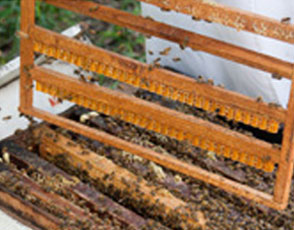What We Do
- TOP >
- What We Do
Our in-house apiary in Thailand
Esprit co. has a in-house apiary in Thailand. Most Royal Jellies were producing in China, but we decided to build a factory in Thailand because of its location. Thailand, where has rich and beautiful nature with great climate, has a potential to produce the best Royal Jelly. We have provided local staff with our guidances in quality.

this is our in-house apiary in Phayao province, Thailand.
Care

Our Policy for Bees
We adopt Fixed beekeeping method, which doesn't need to move for bee forage. We can provide good environment for bees with strict quality control and traceability by this method. We do not use medicines such as antibiotic for bees, and we pay close attention to bees' stress (Their hives can prevent heat and water). And also, their hives' are very comfortable to stay for bees (White-hive style).
We incorporate unique ideas into “white-hive” (our beehive) to keep comfortable.


-

If temperature increase, worker bees'd send wind by flapping own wings to slit so that they make hive cool.
-

We've improved cooling efficiency by changing the hive's position. We put some legs to prevent water intrusion into hive. This improvement also effects to keep suitable temperature and decrease bees' stress.
Natural

Our Royal Jelly is pure, fresh and no-additive
The longer Royal Jelly put in normal temperature, it loses its ingredients.
Fleshless Royal Jelly has less-nourishing for health.
Sooner is better, with the words in our mind, we collect Royal Jelly quickly as possible as we can.
After we collect Royal Jelly, we freeze them quickly to keep it fresh.
Of course we do not add any additive after filtration.
How to harvest Royal Jelly
-
1 Pull out Queen cell

Pull out artificial queen cell with Royal Jelly.
The source of Royal Jelly is absorbed pollen from inside of Young worker bees. -
2 Uncap

Carefully remove by cutting off Beeswax, which is capping queen cell.
-
3 Clean Queen cell

To prevent contamination by foreign substances, clean Queen cell.
-
4 Collect larvae

This is a 3-days-old larva. Usually larvae were born with length of approximately 0.3mm. This picture shows us how fast its growth time.
-
5 Harvest Royal Jelly

Harvest fresh Royal Jelly. we can get 300ml of the fresh Royal Jelly from each cell. A cell is equivalent to a capsule of our Royal Jelly. ※ We use spatula which is made in bamboo. We do not use metal spatula because metal makes Royal Jelly oxidized.
-
6 Graft larvae

Put larvae back into queen cells. We need to follow up this process carefully because if larvae stays over 3 days in its cell, they eat all Royal Jelly!
-
7 Filtration

Filter fresh Royal Jelly to remove impurities within 30 minutes after harvest. We need to finish this process quickly, otherwise Royal Jelly would be oxidized and lose its quality.
-
8 Low‐temperature preservation

Store Royal Jelly at below 5 degrees Celsius in low temperature container after remove impurities by filtering.
Quality

What We Do for Quality Control
Our factory can store products as the most suitable for itself. We filter Royal Jelly within 30 minutes after harvest, and bring to our factory quickly with keeping at below 5 degree Celsius (This is the most suitable temperature). After that, we divide and put 1kg of Royal Jelly in each containers in large cold storage. This storage can keep Royal Jelly at −18 degree Celsius so that we can send it to Japan with the best quality to customer. We adopted Fixed beekeeping way, and we do not add an additive and we strictly observe Medicine GMP to produce.


